Q60 Coupe means alpha-numeric sports-luxury
Spend a few days driving up and down the freeway in the Infiniti Q60 coupe and you will be impressed by the power and the handling and the comfort, and maybe most by the knowledge that you look so darn cool in that sleek sporty car.
After you’re fully acquainted with its driving and handling assets, one of the last items you might find is the little rocker switch on the console, just southwest of the shift lever. Look closely, and you realize it is a driving mode selector. Click it and a readout shows that you can select eco, normal, snow, or sport, or sport-plus.
With most of these devices, your car might already be firm enough, and making it firmer could become harsh. The Q60, however, is firm enough but never even hints at harsh, so switching it to Sport-plus turned it into a quite-different ride. Quicker steering, firmer cornering feel, and an engine that goes from swift to swifter, making you feel that you should use the steering wheel paddles to truly appreciate the sportiness yoiu’ve discovered.
The car in question is not just the Q60, but a beautiful rad metallic color that defines its full name — the 2018 Infiniti Q60 Red Sport 400 AWD. Flipping that switch, which goes back to a default “standard” setting when you start up again, transforms the vehicle from a beautiful boulevardiering sports coupe into something that feels like it might have been designed for the track but allowed out on the street.
You may be, as I am, forced to stop and think whenever Nissan-Infiniti hits you with a name that starts with Q, or QX where there used to be G and a number. But whatever the designation, the technology remains ever-improving.
If you aren’t currently impressed with what Nissan/Infiniti has been doing with engines in recent years, you haven’t been paying attention. It’s highest-tech 2.0-liter turbocharged 4 is amazing, and Mercedes uses it in its C-Class and smaller sportier SUVs. It is just bringing to market a new concept that involves variable compression, which alters the engines compression ratio and thus provides almost infinite valve-timing range.
The Q60 Red Sport 400 rises to a different plateau, using a3.0-liter twin-turbocharged V6 that channels 400 horsepower and 350 foot-pounds of torque to Infiniti’s intelligent all-wheel-drive system. It is driven via a 7-speed automatic that is quick-shifting to the point that you’ll either have to shift to manual mode or be very quick to beat it with the manual-shift paddles.
There is a rear seat, under that sloping rear window and close behind the well-designed and supporting front bucket seats. I could fit back there, and it would be fine for kids or short folks, although a 6-footer might not care to ride back there for a couple hundred miles. Not that you’d care, if you were in the market to spend about $65,000 for this sleek bundle of technology, and then a lot of adults might not mind riding back there just to be on board such a car.
Base price, by the way, is $54,000, and gives you the drivetrain, the all-wheel-drive system, and enough of the goodies to make it a terrific car. Adding the Red Sport package accumulates the appearance, technical, and sporty options. High performance brakes come with special 20-inch alloy wheels and higher performance tires, and you can spot the red-tipped exhaust pipes, red brake calipers, and upgraded interior features.
The 3.0-V6 turbo has great thrust, with those 400 horsepower, and I was pleasantly surprised when I recorded a consistent 25.4 miles per gallon in mostly city driving. The EPA estimated highway mileage is 26 mpg, and I never really got it out on a worthy freeway trip to better that figure.
The Sensory package comes on the Sport, and includes InTlouch navigation with voice recognition, while the ProAssist package adds blind spot warning, rear cross traffic alert, backup collision intervention, surround video monitor with moving object detection, sonar front and rear detection gadgets, forward collision warning and emergency braking with pedestrian detection, and rain-sensing wipers.
The Proactive package lists the adaptive cruise control, adap0tive steering, lane departure prevention, blind spot intervention, adaptive front lighting with auto-leveling headlights, and high beam assist, which has become one of my wife, Joan’s, favorite assets. Especially with those LED lights.
The 8-way power and heated-cooled front bucket seats can bolster your back cushioning and alter every angle, and you also can telescope the steering wheel, then secure all those setting with a button on the door, so changing drivers won’t necessitate resetting all that, a mere push of the button resets everything,
Carbon-fiber trim is the rage these days, and along with all the soft leather inside, you get silver fiber-optic trim on the console and doors, and from a structural standpoint, the rear decklid, external mirror covers, fender vents and fog-lamp enclosures are also carbon-fiber for structural lightness.
Also, that neat dark red metallic paint costs an extra $800, but don’t dismiss that until you examine the luster of the unique paint.
Altogether, those option packages with all the top-line safety stuff, such as brake force distribution, dynamic enhancement with traction control, and the tire-specific air pressure monitoring, all coordinated to enhance safety and comfort, bring the sticker to $65,795.
Brilliant LED headlights and foglights and rear brake lights are quickly visible and throw amazing amounts of light down the road. The voice recognition also works with the Bluetooth phone system, and for audio, streaming audio and vehicle information, as well as text-messaging assistance.
The audio is a Bose Centerpoint system with 13 speakers working with surround sound.
With all the latest methods of modern transportation, Nissan is at the leading edge with electric, variable-compression, and turbocharging to extract maximum performance from limited displacement. But it does your heart good to know that the company can also arm one of its Infiniti specialty cars with high-tech equipment that might even be more contemporary than futuristic.


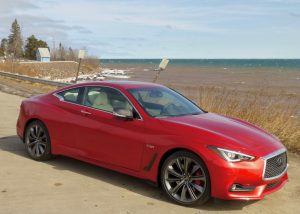
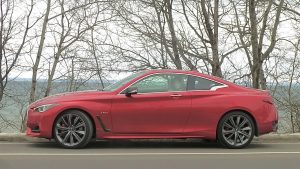
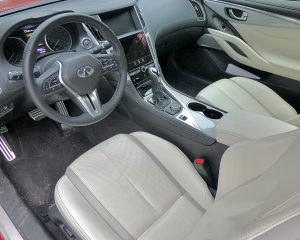
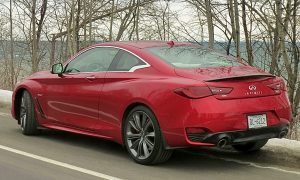
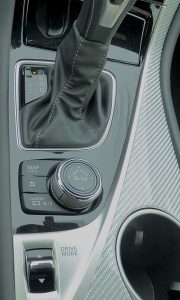
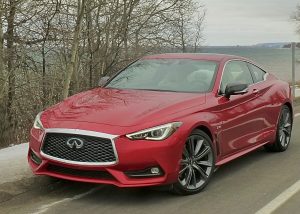
 John Gilbert is a lifetime Minnesotan and career journalist, specializing in cars and sports during and since spending 30 years at the Minneapolis Tribune, now the Star Tribune. More recently, he has continued translating the high-tech world of autos and sharing his passionate insights as a freelance writer/photographer/broadcaster. A member of the prestigious North American Car and Truck of the Year jury since 1993. John can be heard Monday-Friday from 9-11am on 610 KDAL(www.kdal610.com) on the "John Gilbert Show," and writes a column in the Duluth Reader.
John Gilbert is a lifetime Minnesotan and career journalist, specializing in cars and sports during and since spending 30 years at the Minneapolis Tribune, now the Star Tribune. More recently, he has continued translating the high-tech world of autos and sharing his passionate insights as a freelance writer/photographer/broadcaster. A member of the prestigious North American Car and Truck of the Year jury since 1993. John can be heard Monday-Friday from 9-11am on 610 KDAL(www.kdal610.com) on the "John Gilbert Show," and writes a column in the Duluth Reader.